

Welcome to Our Jacobean/Elizabethan Fashion Show
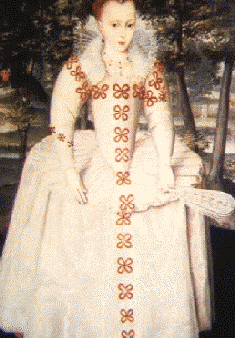
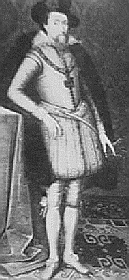 Yes indeed, it is His Majesty King James I first down the ramp in 1604 to kick
off our latest collection. He is wearing a very popular styled suit with
doublet slightly padded at the front.
The paned trunk
-hose are padded into a smooth shape. The velvet, the brightest on the
market, is - dare we say- almost "explosive".
Yes indeed, it is His Majesty King James I first down the ramp in 1604 to kick
off our latest collection. He is wearing a very popular styled suit with
doublet slightly padded at the front.
The paned trunk
-hose are padded into a smooth shape. The velvet, the brightest on the
market, is - dare we say- almost "explosive".
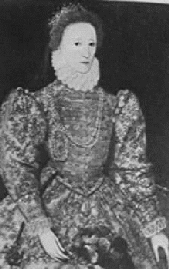
We just couldn't resist this revival of one of our classic gowns made for the late Queen Elizabeth I in 1580. The trademark curved seam running down the outside of the arm is styled to be worn under a long hanging sleeve. We still feature this sleeve style with the fine braid decorating it on the outside as worn here. As always we pride ourselves on the many layers of fine fabrics and bright silks and the many folds which add a sculpted depth to our bodices and kirtles (petticoats).
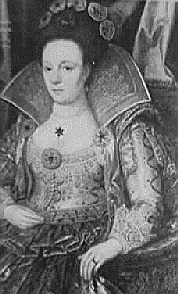 Francis Cavendish, Lady Maynard, in 1615, shows off a brilliant collar and a
rich,softly
pleated flounce unsupported by a farthingale. Our flounces make the
wearers
the very flower of the gown itself.
We can work wonders on unshapely bodies with "pairs of bodies,"
a corset which is stiffened with either the finest bents or whalebone.
We can be flexible and can provide low square necklines or a loose gown
over a waistless kirtle. Let us know.
Francis Cavendish, Lady Maynard, in 1615, shows off a brilliant collar and a
rich,softly
pleated flounce unsupported by a farthingale. Our flounces make the
wearers
the very flower of the gown itself.
We can work wonders on unshapely bodies with "pairs of bodies,"
a corset which is stiffened with either the finest bents or whalebone.
We can be flexible and can provide low square necklines or a loose gown
over a waistless kirtle. Let us know.
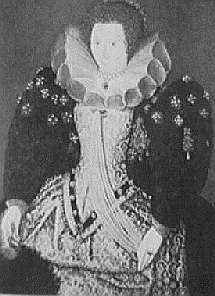 Here comes Mrs. Ralph Sheldon from 1590 wearing one of our black silk damask
gowns
It features the ever-fashionable
big sleeves. It can be either bombasted or born out over whalebones over
a kirtle of light brown and pale grey silk woven in a pattern of acorns,
roses and other flowers, with silver metal thread in the weft. The skirt
is supported with a half roll and is caught up with a tuck at the
front.
Here comes Mrs. Ralph Sheldon from 1590 wearing one of our black silk damask
gowns
It features the ever-fashionable
big sleeves. It can be either bombasted or born out over whalebones over
a kirtle of light brown and pale grey silk woven in a pattern of acorns,
roses and other flowers, with silver metal thread in the weft. The skirt
is supported with a half roll and is caught up with a tuck at the
front.
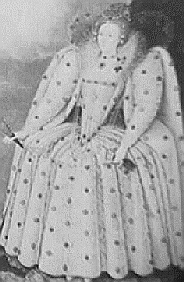 We end with another favorite from the immortal collection of our late
Queen Elizabeth I from 1595.
Still popular, these elegant gowns with carefully pleated flounces create
even of the most ordinary woman an elegant flower.
We end with another favorite from the immortal collection of our late
Queen Elizabeth I from 1595.
Still popular, these elegant gowns with carefully pleated flounces create
even of the most ordinary woman an elegant flower.
This ends our most recent collection of elegant court creations. As you can see, despite the Scots now arriving at the court in ever greater numbers, the glory of our tradition continues.
This Show Sponsored by:
Gunpowder Farthingales
"Strong as the halls of
Parliament"
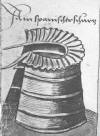
Farthingale I
Arnold,Janet, Patterns of Fashion,The cut and construction of clothes for men and women c. 1550-1620, Drama Book, New York,1995.
How do you dress your Guy? Let us know!
 Midi Music Thomas Campion, 1567-1620, I Care not for These
Ladyes," 25k
Midi Music Thomas Campion, 1567-1620, I Care not for These
Ladyes," 25k